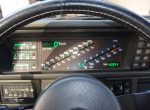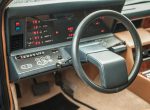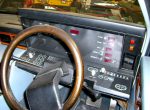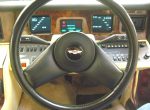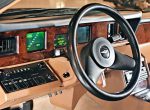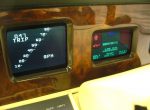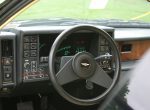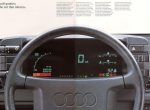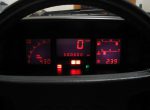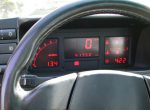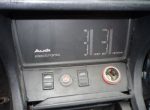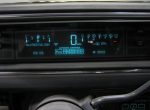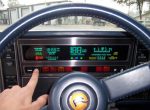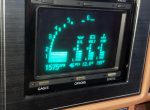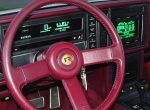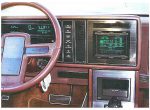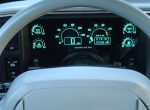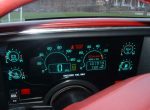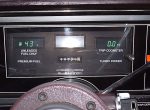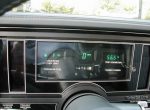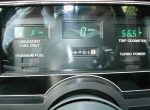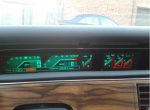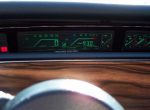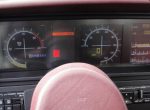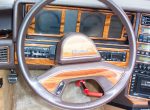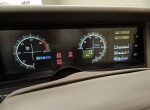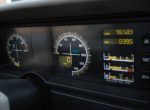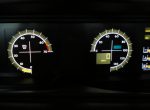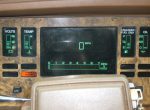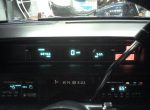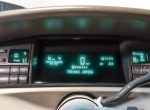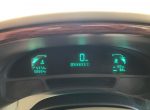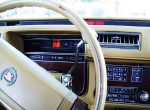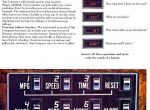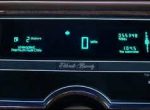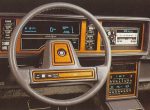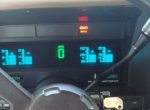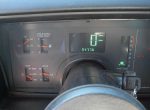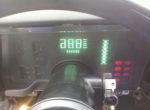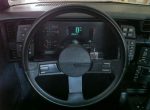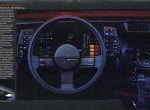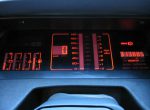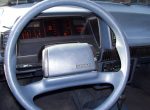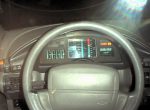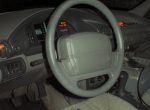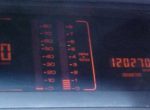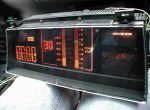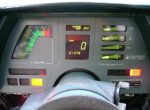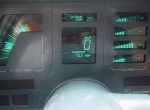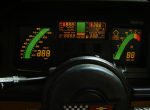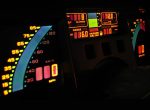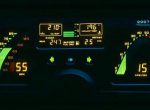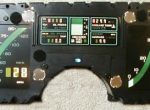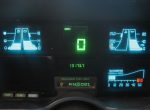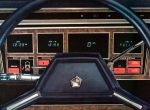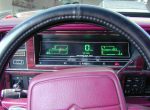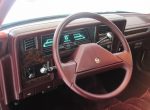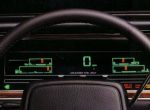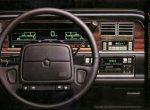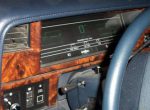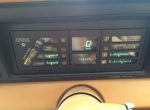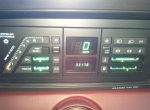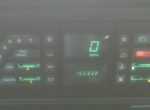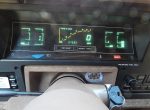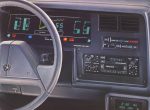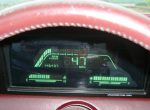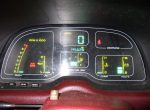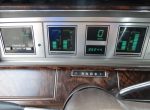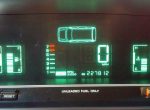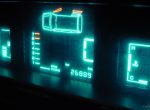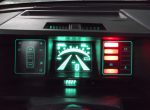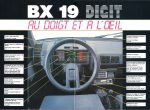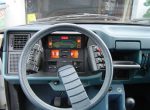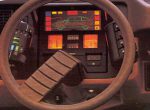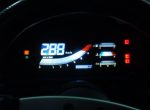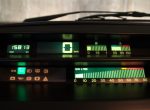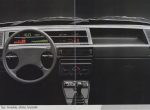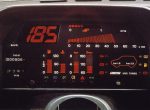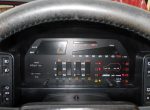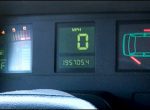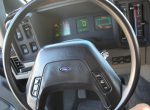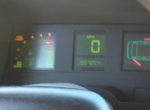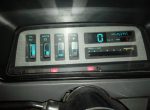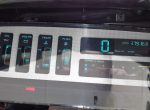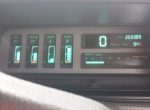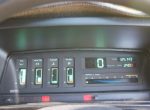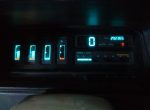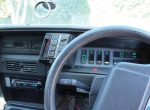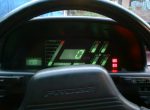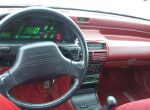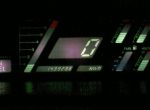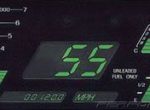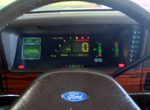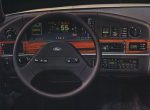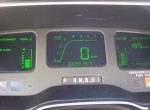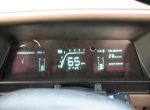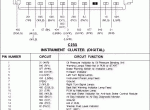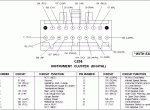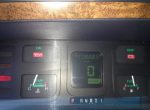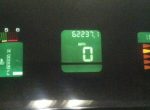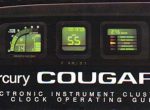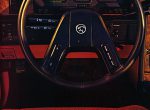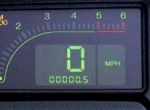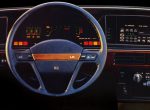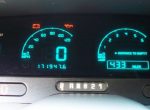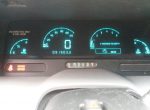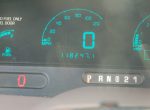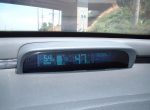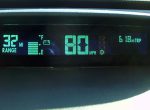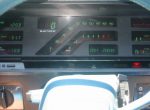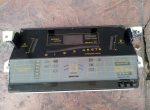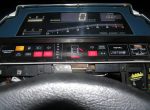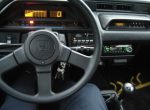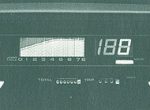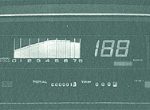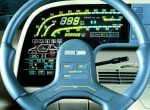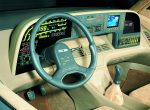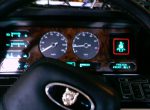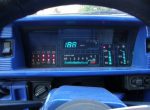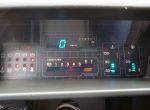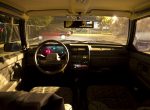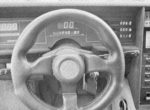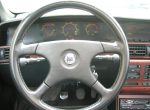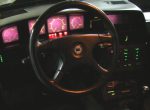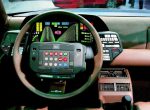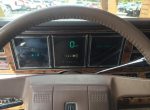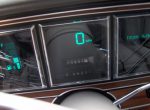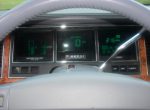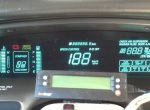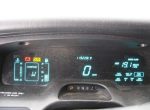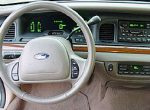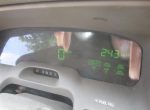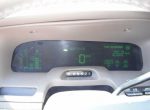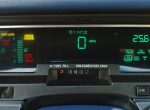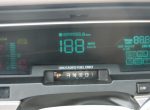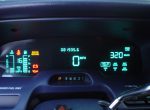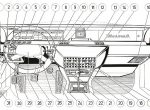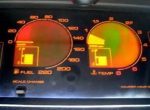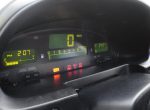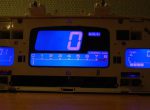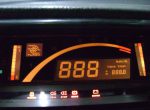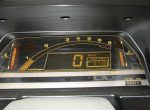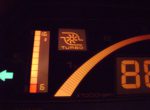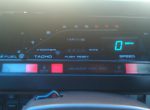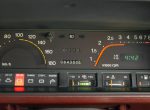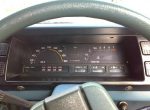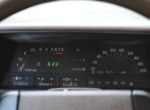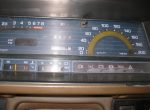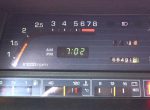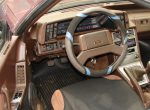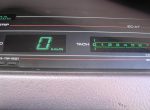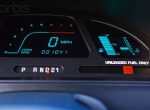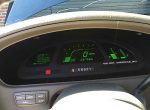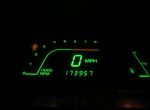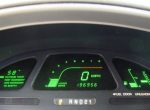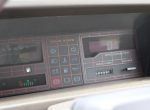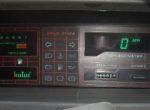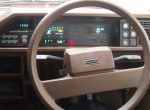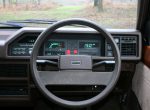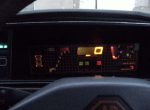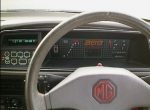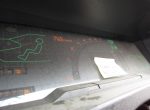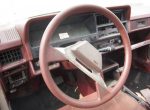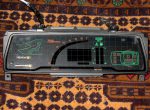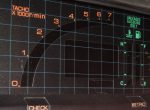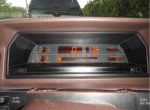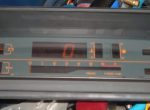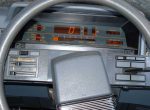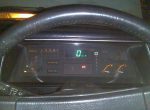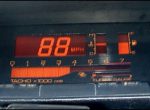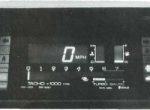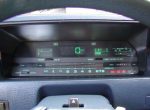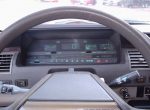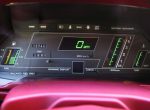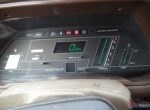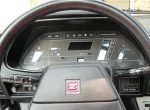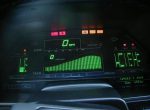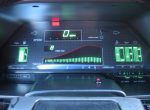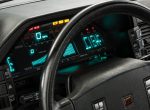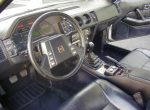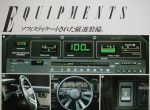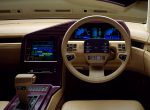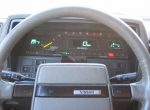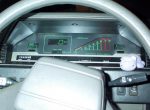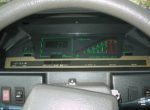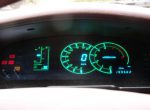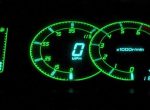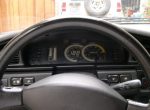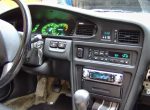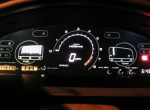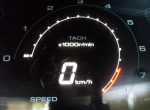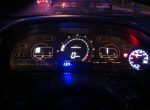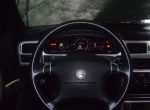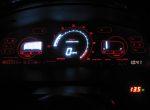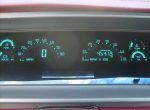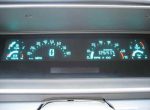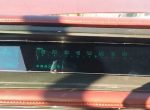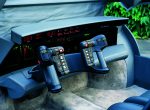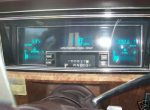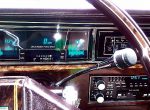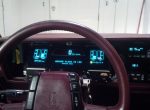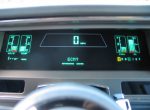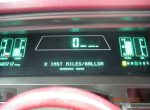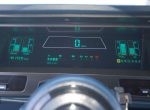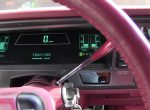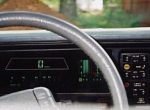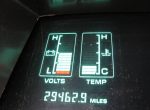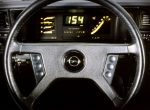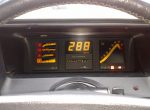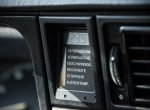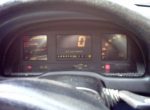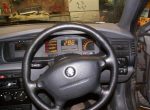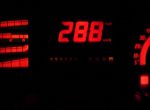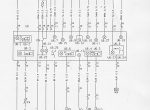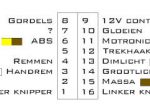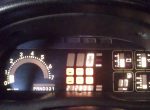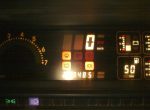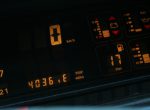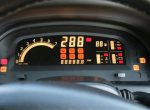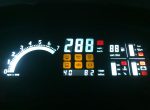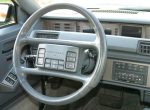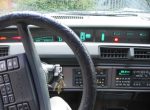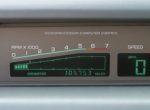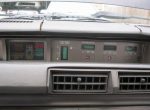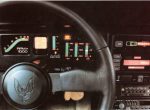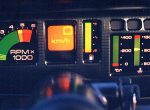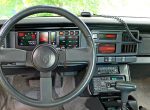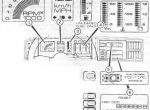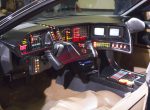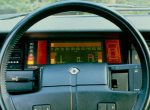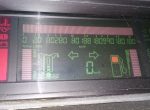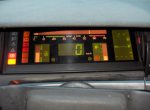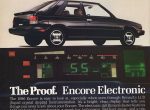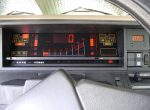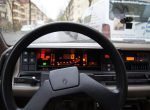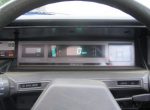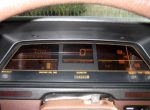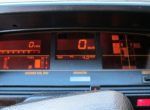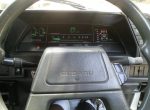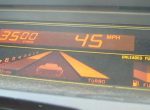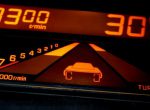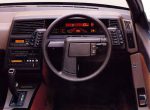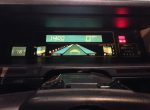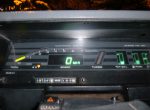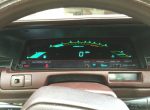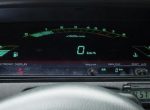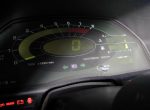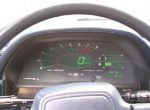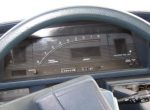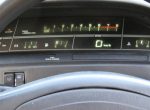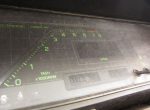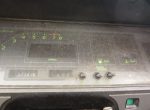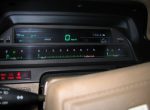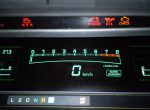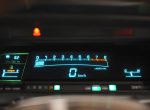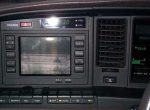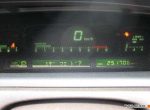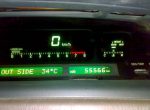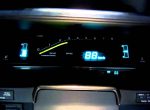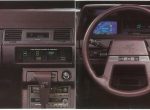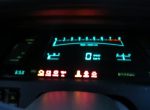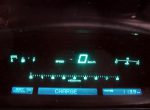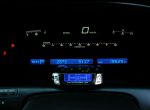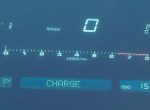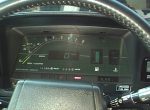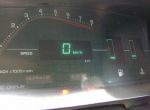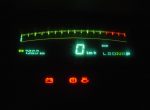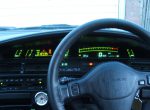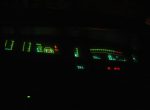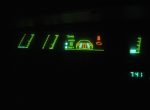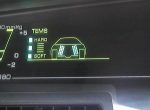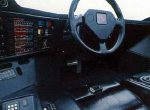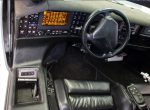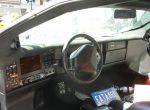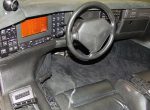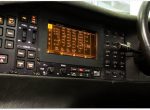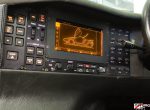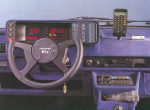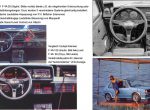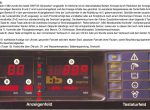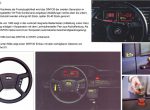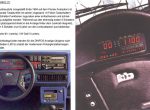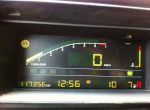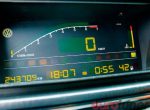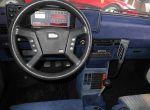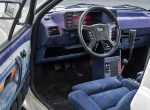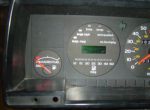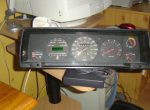Most new cars have some digital elements in their instrument clusters, but it’s often limited to the speedometer. However, in the 1980s and 1990s some car manufacturers experimented with and actually implemented fully digital dashboards in their production cars, resulting in very interesting concepts.
I have been collecting images of these dashboards, found on forums and pages all over the net, and compiled them here. It was once my intention to install a digital instrument cluster in my car, but as it required significant work, this never happened.
Currently my collection contains as good as all digital instrument clusters from the 1980s and 1990s. If you find one that happens not to be listed, please contact me, hopefully with an image! I do reply to all my messages. Note: I do not have anything for sale.
Of course, to everybody who sent me updates: thanks!
This page was last modified on 13 February 2019.
The cars
- Alfa Romeo 90 QO
- Aston Martin Lagonda
- Audi Coupe GT
- Audi Quattro 20V
- Buick Electra
- Buick LeSabre
- Buick Reatta
- Buick Regal
- Buick Riviera
- Cadillac Allanté
- Cadillac Cimarron
- Cadillac de Ville
- Cadillac Eldorado
- Cadillac Seville
- Chevrolet Astro
- Chevrolet Beretta
- Chevrolet Camaro Berlinetta
- Chevrolet Cavalier Z24
- Chevrolet Corvette
- Chevrolet S10
- Chevrolet Senator
- Chrysler Imperial
- Chrysler Laser
- Chrysler LeBaron
- Chrysler New Yorker
- Chrysler Town & Country
- Citroen BX
- Citroen GS, GSA (looks digital, actually isn’t)
- Daewoo Nexia
- Datsun 280ZX
- Dodge 600ES
- Dodge Daytona
- Fiat Tempra
- Fiat Tipo
- Fiat Uno
- Ford Aerostar
- Ford Crown Victoria
- Ford Fairlane
- Ford Fairmont
- Ford Probe
- Ford Taurus
- Ford Thunderbird
- Ford Windstar
- GM EV1
- Holden Calais
- Honda Accord
- Honda Ballade
- Honda Civic
- Italdesign Orbit
- Jaguar XJ40
- Lada Samara
- Lamborghini Countach
- Lancia Dedra
- Lancia Orca
- Lancia (Autobianchi) Y10 Turbo
- Lincoln Town Car
- Maserati Quattroporte
- Mazda 323
- Mazda 626
- Mazda 929
- Mercury Cougar
- Mercury Grand Marquis
- Mercury Sable
- Mercury Villager
- MG Maestro
- MG Montego
- Mitsubishi Conquest
- Mitsubishi Cordia
- Mitsubishi Galant
- Mitsubishi Sigma
- Mitsubishi Starion
- Nissan 200SX
- Nissan 280ZX
- Nissan 300ZX
- Nissan Bluebird
- Nissan CUE-X Concept
- Nissan Laurel
- Nissan Maxima
- Nissan NX
- Oldsmobile Cutlass Supreme
- Oldsmobile Delta 88
- Oldsmobile Incas
- Oldsmobile Toronado
- Opel Kadett
- Opel Monza
- Opel Omega
- Opel Senator
- Opel Vectra
- Pontiac 6000
- Pontiac Firebird
- Renault 11
- Renault 21
- Subaru Leone
- Subaru XT
- Toyota 4Runner
- Toyota Camry
- Toyota Celica
- Toyota Corolla
- Toyota Cressida
- Toyota Crown
- Toyota Soarer
- Toyota Supra
- Vanden Plas Maestro
- Vector W2
- Vector W8
- Volkswagen Golf
- Volkswagen Polo
- Volvo 700
In the 2000s, digital speedos have become more common, but some show more than just the speed digitally.
Surprisingly, there are also some motorcycles with retro digital dashboards.
Finally, there are some beautifully designed TFT dashboards out there, which are of course much more recent.
The images
Alfa Romeo 90 QO (1984-1986)
- Alfa Romeo 90 QO (1984-1986)
- Alfa Romeo 90 QO (1984-1986)
- Alfa Romeo 90 QO (1984-1986)
Aston Martin Lagonda (1974-1975, 1976-1985, 1986-1987)
- Aston Martin Lagonda (1974-1975)
- Aston Martin Lagonda (1974-1975)
- Aston Martin Lagonda (1976-1985)
- Aston Martin Lagonda (1976-1985)
- Aston Martin Lagonda (1976-1985)
- Aston Martin Lagonda (1986-1987)
Audi Coupe GT, Audi Quattro 20V (1984-1986)
- Audi Coupe GT (1984-1986)
- Audi Quattro 20V (1984-1986)
- Audi Quattro 20V (1984-1986)
- Audi Quattro 20V (1984-1986). Detail of battery and temperature control
Video of working cluster (green), with female voice providing diagnostic errors.
Website explaining dashboard diagnostics.
Buick Electra (1985-1990), Buick LeSabre (1986-1991)
The part number for this cluster (25083394) also fits the Oldsmobile Delta 88. However, the original Oldsmobile Delta 88 cluster looks different from the Buick.
- Buick LeSabre (1986-1991)
- Buick LeSabre (1986-1991)
Buick Reatta, Buick Riviera (1988-1989, 1990-1991)
While the car itself remained the same, the Buick Reatta and Riviera received a revised interior in 1990, which also changed the design of the dashboard.
- Buick Reatta, Buick Riviera (1988-1989)
- Buick Reatta, Buick Riviera (1988-1989). Information and control touch-screen.
- Buick Reatta, Buick Riviera (1988-1989)
- Buick Reatta, Buick Riviera (1988-1989)
- Buick Reatta, Buick Riviera (1990-1991)
- Buick Reatta, Buick Riviera (1990-1991)
Video showing the ‘lightshow’ when the car is turned on.
Video (6.5 minutes) of all functions of the information and control touch-screen.
Buick Regal (1986-1988)
The Buick Regal came in several different editions. The following editions had digital dashboards (which also varied per type):
- T-Type (1986)
- Grand National (1987)
- Limited Coupe (1988)
- Buick Regal T-Type (1986), Buick Regal Grand National (1987)
- Buick Regal T-Type (1986), Buick Regal Grand National (1987)
- Buick Regal T-Type (1986), Buick Regal Grand National (1987)
- Buick Regal Limited Coupe (1988)
- Buick Regal Limited Coupe (1988)
Video of working cluster of Limited Coupe.
Cadillac Allanté (1987-1993)
Notice that while the dash layout has stayed the same, the lighting of the warnings has received slight display improvements.
- Cadillac Allanté (1987-1993). Note the older style warning lights.
- Cadillac Allanté (1987-1993)
- Cadillac Allanté (1987-1993)
- Cadillac Allanté (1987-1993)
- Cadillac Allanté (1987-1993)
- Cadillac Allanté (1987-1993). Detail of speedo.
Cadillac Cimarron (1986-1988)
- Cadillac Cimarron (1986-1988)
- Cadillac Cimarron (1986-1988)
Cadillac de Ville (DeVille) (1985-1993, 1994-1999, 2000-2005)
- Cadillac de Ville (1985-1993)
- Cadillac de Ville (1994-1999)
- Cadillac de Ville (2000-2005)
Cadillac Eldorado, Cadillac Seville (1978-1979, 1981-1985)
- Cadillac Seville, Cadillac Eldorado (1978-1979)
- Cadillac Seville, Cadillac Eldorado (1978-1979). Brochure section on trip computer.
- Cadillac Seville, Cadillac Eldorado (1981-1985)
- Cadillac Seville, Cadillac Eldorado (1981-1985)
Chevrolet Astro (1994)
- Chevrolet Astro (1994)
Chevrolet Camaro Berlinetta (1984)
- Chevrolet Camaro Berlinetta (1984)
- Chevrolet Camaro Berlinetta (1984)
- Chevrolet Camaro Berlinetta (1984)
- Chevrolet Camaro Berlinetta (1984). Excerpt from brochure.
Chevrolet Beretta (1989)
Images show both red and green versions, but little detail is known about this dashboard.
- Chevrolet Beretta (1989)
- Chevrolet Beretta (1989)
- Chevrolet Beretta (1989)
- Chevrolet Beretta (1989)
- Chevrolet Beretta (1989). Detail of right side.
- Chevrolet Beretta (1989)
Chevrolet Cavalier Z24 (1986-1989)
- Chevrolet Cavalier Z24 (1986-1989)
- Chevrolet Cavalier Z24 (1986-1989)
Chevrolet Corvette (1984-1989)
The fourth generation Corvette, before the ZR-1 arrived in 1990, had a digital dashboard. Note that the 1984 dashboard is slightly different than the other version (see the different shape of the RPM curve). For people interested in using this dashboard, eBay seems to have plenty for sale.
- Chevrolet Corvette (1984-1989)
- Chevrolet Corvette (1984-1989)
- Chevrolet Corvette (1984-1989). Dashboard as in brochure.
- Chevrolet Corvette (1984-1989)
- Chevrolet Corvette (1984-1989)
- Chevrolet Corvette (1984-1989). This is the slightly different 1984 dash.
Chevrolet S10 (1989-1994)
The 4WD version of the S-10 is also known as the Chevrolet Blazer or GMC Jimmy.
- Chevrolet S10 (1989-1994)
- Chevrolet S10 (1989-1994)
Video of working cluster.
Video of modified cluster, but with car starting. Notice the fancy animation for the indicators!
Chrysler Imperial (1981-1983, 1990-1993)
The Chrysler Imperial (1981-1983) dashboard was the same as the Chrysler LeBaron (1981). However, the Chrysler Imperial (1990) received a different dashboard than the Chrysler LeBaron at that time. Also, the dashboard of the Chrysler Imperial (1990-1993) was the same as the Chrysler New Yorker (1988-1993).
- Chrysler Imperial (1981-1983), Chrysler LeBaron (1981)
- Chrysler New Yorker (1988-1993), Chrysler Imperial (1990-1993)
- Chrysler New Yorker (1988-1993), Chrysler Imperial (1990-1993)
- Chrysler New Yorker (1988-1993), Chrysler Imperial (1990-1993)
- Chrysler New Yorker (1988-1993), Chrysler Imperial (1990-1993)
- Chrysler New Yorker (1988-1993), Chrysler Imperial (1990-1993)
Video of working 1990-1993 cluster.
Chrysler Laser (1984-1987)
Note that this dashboard was also available on the Dodge Daytona (1984-1987).
- Chrysler Laser, Dodge Daytona (1984-1987)
- Chrysler Laser, Dodge Daytona (1984-1987)
- Chrysler Laser, Dodge Daytona (1984-1987)
- Chrysler Laser, Dodge Daytona (1984-1987)
Chrysler LeBaron (1981, 1987-1988,1989-1990, 1990-1995)
To make it confusing, there were four different digital dashboards on the LeBaron, which could also be found on other models.
The dashboard of the Chrysler LeBaron (1981) was the same as the Chrysler Imperial (1981-1983).
The dashboard of the Chrysler LeBaron (1989-1990) was the same as the Dodge Daytona (1987, Shelby Z only).
The dashboard of the Chrysler Lebaron (1990-1995) was the same as the Dodge Daytona (1990-1993).
- Chrysler Imperial (1981-1983), Chrysler LeBaron (1981)
- Chrysler LeBaron (1987-1988)
- Chrysler LeBaron (1987-1988)
- Chrysler LeBaron (1989-1990), Dodge Daytona Shelby Z (1987)
- Chrysler LeBaron (1989-1990), Dodge Daytona Shelby Z (1987)
- Chrysler LeBaron (1990-1995), Dodge Daytona (1990-1993)
- Chrysler LeBaron (1990-1995), Dodge Daytona (1990-1993)
Video of working and talking (LeBaron 1989-1990, Daytona 1987) cluster.
Video of working (LeBaron 1990-1995, Daytona 1990-1993) cluster.
Chrysler New Yorker (1986-1988, 1988-1993)
The dashboard of the Chrysler New Yorker (1988-1993) was also implemented in the Chrysler Imperial (1990-1993).
- Chrysler New Yorker (1986-1988)
- Chrysler New Yorker (1986-1988)
- Chrysler New Yorker (1988-1993), Chrysler Imperial (1990-1993)
- Chrysler New Yorker (1988-1993), Chrysler Imperial (1990-1993)
- Chrysler New Yorker (1988-1993), Chrysler Imperial (1990-1993)
- Chrysler New Yorker (1988-1993), Chrysler Imperial (1990-1993)
- Chrysler New Yorker (1988-1993), Chrysler Imperial (1990-1993)
Video of working 1986-1987 cluster (talking).
Chrysler Town & Country (1991-1995)
- Chrysler Town & Country (1991-1995)
- Chrysler Town & Country (1991-1995)
- Chrysler Town & Country (1991-1995)
Citroen BX (1985)
A limited-edition of the BX, the 19 DIGIT, was released in 1985, and featured a digital dashboard. Although the original dashboard of the BX looks digital, it is not. It does have a very novel way of displaying the RPM.
- Citroen BX DIGIT (1985)
- Citroen BX DIGIT brochure
- Original Citroen BX (not digital)
Citroen GS, Citroen GSA (1970-1976)
This is the only non-digital dashboard in this list. The reason is its very digital-looking dashboard, with the warning lights taking up the most of the dashboard, and the rotating drums as speedo and rev counter (which work like bathroom scales).
- Citroen GSA (1970-1976)
- Citroen GSA (1970-1976)
Daewoo Nexia (1984-1991)
This dashboard might also be installed in a Daewoo Cielo of the same period, but not much is known. One thing has been clarified: while the Daewoo Cielo or Daewoo Nexia might have been branded as Opel, Chevrolet, or Vauxhall, they were not found in Opels.
- Daewoo Cielo, Daewoo Nexia (1984-1991)
- Daewoo Cielo, Daewoo Nexia (1984-1991)
Dodge Daytona (1984-1987, 1987, 1990-1993)
The Dodge Daytona received three different dashboards, which could also be found on other models.
The dashboard of the Dodge Daytona (1984-1987) was the same as the Chrysler Laser (1984-1987).
The dashboard of the Dodge Daytona Shelby Z (1987) was the same as the Chrysler LeBaron (1989-1990).
The dashboard of the Dodge Daytona (1990-1993) was the same as the Chrysler LeBaron (1990-1995).
- Chrysler Laser, Dodge Daytona (1984-1987)
- Chrysler Laser, Dodge Daytona (1984-1987)
- Chrysler Laser, Dodge Daytona (1984-1987)
- Chrysler Laser, Dodge Daytona (1984-1987)
- Chrysler LeBaron (1989-1990), Dodge Daytona Shelby Z (1987)
- Chrysler LeBaron (1989-1990), Dodge Daytona Shelby Z (1987)
- Chrysler LeBaron (1990-1995), Dodge Daytona (1990-1993)
- Chrysler LeBaron (1990-1995), Dodge Daytona (1990-1993)
Video of working and talking (LeBaron 1989-1990, Daytona 1987) cluster.
Video of working (LeBaron 1990-1995, Daytona 1990-1993) cluster.
Fiat Tempra (1990-1999), Fiat Tipo (1988-1995)
- Fiat Tempra (1990-1999), Fiat Tipo (1988-1995)
- Fiat Tempra (1990-1999), Fiat Tipo (1988-1995)
- Fiat Tempra (1990-1999), Fiat Tipo (1988-1995)
- Full dashboard as shown in brochure.
Fiat Uno Turbo (1985-1989)
- Fiat Uno Turbo (1985-1989)
- Fiat Uno Turbo (1985-1989)
- Fiat Uno Turbo (1985-1989)
Ford Aerostar (1986-1992)
- Ford Aerostar (1986-1992)
- Ford Aerostar (1986-1992)
- Ford Aerostar (1986-1992)
Ford Fairlane, Ford Fairmont (1984-1988)
While the dashboard was originally from the Fairmont and Fairlane, many people have been installing it in the Ford Falcon, which is now the most returned search result for this dashboard. Also, its original background is silver, instead of the black you see in many photos (which is another modification performed on the dashboard).
- Ford Fairmont, Ford Fairlane (1984-1988)
- Ford Fairmont, Ford Fairlane (1984-1988)
- Ford Fairmont, Ford Fairlane (1984-1988)
- Ford Fairmont, Ford Fairlane (1984-1988)
- Ford Fairmont, Ford Fairlane (1984-1988)
- Ford Fairmont, Ford Fairlane (1984-1988)
Video of working cluster (installed in Falcon).
Ford Probe (1989-1992)
While it already had the availability of a digital dashboard, there are also instructions available on how to modify a Mercury Villager cluster to fit in the Ford Probe.
- Ford Probe (1989-1992)
- Ford Probe (1989-1992)
- Ford Probe (1989-1992)
- Ford Probe (1989-1992)
Ford Taurus, Mercury Sable (1986-1989, 1990-1995)
Note that the years represent the dashboards, not the generations of the cars themselves. The first generation car (which ran until 1991) already received updated dashboards in 1990. Also, the 1990-1991 dashboard had green lights, while the 1992-1995 dashboard were a bit more blueish.
- Ford Taurus, Mercury Sable (1986-1989)
- Ford Taurus, Mercury Sable (1986-1989)
- Ford Taurus, Mercury Sable (1990-1991)
- Ford Taurus, Mercury Sable (1992-1995)
- Ford Taurus, Mercury Sable (1992-1995)
- Ford Taurus pinout connector A
- Ford Taurus pinout connector B
Video of working cluster (first generation).
Video of working cluster (second generation).
Ford Thunderbird, Mercury Cougar (1987-1988,1989-1993)
For the first generation, even the standard dashboard featured a digital display of the speed and mileage. However, a full digital dashboard was also offered.
- Ford Thunderbird, Mercury Cougar (1987-1989, standard dash)
- Ford Thunderbird, Mercury Cougar (1987-1989, standard dash)
- Ford Thunderbird, Mercury Cougar (1987-1989)
- Cover of dash operating guide for Mercury Cougar (1987-1989)
- Photo of brochure for Mercury Cougar (1987-1989)
- Ford Thunderbird, Mercury Cougar (1989-1993)
- Photo of brochure for Ford Thunderbird (1989-1993)
- Ford Thunderbird, Mercury Cougar (1989-1993)
Video of working cluster (first generation).
Video of working cluster (second generation).
Ford Windstar (1995-1998)
- Ford Windstar (1995-1998)
- Ford Windstar (1995-1998)
- Ford Windstar (1995-1998)
GM EV1 (1996-1999)
The full-electric car had a full digital dashboard as well. You can only see this car in museums, as GM crushed (almost) all of them, in what some think is a conspiracy. It sparked the creation of a documentary film specifically on this car, named ‘Who Killed the Electric Car?’.
- GM EV1 (1996-1999)
- GM EV1 (1996-1999)
Holden Calais (1984-1986)
- Holden Calais (1984-1986)
Honda Accord (1981-1985, 1986-1989)
This dashboard was only an option in Japan for the top of the range model.
- Honda Accord (1981-1985)
- Honda Accord (1981-1985)
- Honda Accord (1986-1989)
Honda Ballade, Honda Civic (1984-1987)
Only the Japanese ’35i’ and ‘CR-i’ types had the option to choose this digital dashboard instead of the default analogue cluster. While the center digital display is the same, the surrounding cluster organisation can be different, as seen in the following pictures.
- Honda Ballade, Honda Civic (1984-1987)
- Honda Ballade, Honda Civic (1984-1987)
- From the Japanese brochure. Note the different alignments.
- From the Japanese brochure. Note the different alignments.
Italdesign Orbit (prototype, 1986)
- Italdesign Orbit (prototype, 1986)
- Italdesign Orbit (prototype, 1986)
Jaguar XJ40 (1988-1990)
Interestingly, the digital dashboard was discontinued in 1990, and the car received analog clusters until the last of the XJ40s were produced in 1994.
- Jaguar XJ40 (1988-1990)
- Jaguar XJ40 (1988-1990)
Lada Samara (1987-2004)
Only 1500 cars were made to have this dashboard. And, if you’re interested in ordering it, its part number is 43501.1 21093-3856010.
- Lada Samara (1987-2004)
- Lada Samara (1987-2004)
- Lada Samara (1987-2004)
- Lada Samara (1987-2004)
- Lada Samara (1987-2004)
Lamborghini Countach (prototype, 1971)
The Lamborghini Countach LP500 Prototipo was designed to have fully digital instrumentation. Only one car was made, which was subsequently used in crash testing for the production models (that did not use digital instrumentation).
- Lamborghini Countach (prototype, 1971)
Lancia Dedra (1992-1995)
- Lancia Dedra (1992-1995)
- Lancia Dedra (1992-1995)
- Lancia Dedra (1992-1995)
Video of working cluster (startup).
Video of working cluster (driving).
Video of warning screen and cluster closeups.
Lancia Orca (Italdesign prototype, 1982)
- Lancia Orca (Italdesign prototype, 1982)
Lancia (Autobianchi) Y10 Turbo (1985-1988)
- Lancia (Autobianchi) Y10 (1985-1988)
Lincoln Town Car (1981-1989, 1990-1994, 1995-1997, 1998-1999)
The first (1981-1989) and second (1990-1994) generation dashboards look very similar to that of the first generation Chrysler New Yorker, but are different. The fourth generation dashboard (1998-1999) was the same as the Ford Crown Victoria (1998-1999) and Mercury Grand Marquis (1995-2004), and is little different from the second generation.
- Lincoln Town Car (1981-1989)
- Lincoln Town Car (1981-1989). Note the side displays being different from the second generation.
- Lincoln Town Car (1990-1994)
- Lincoln Town Car (1995-1997)
- Lincoln Town Car (1995-1997)
- Ford Crown Victoria (1998-1999), Lincoln Town Car (1998-1999), Mercury Grand Marquis (1995-2004)
- Ford Crown Victoria (1998-1999), Lincoln Town Car (1998-1999), Mercury Grand Marquis (1995-2004)
- Ford Crown Victoria (1998-1999), Lincoln Town Car (1998-1999), Mercury Grand Marquis (1995-2004)
- Ford Crown Victoria (1998-1999), Lincoln Town Car (1998-1999), Mercury Grand Marquis (1995-2004)
- Ford Crown Victoria (1998-1999), Lincoln Town Car (1998-1999), Mercury Grand Marquis (1995-2004)
Video of working cluster (first generation).
Video of working cluster (second generation).
Mercury Grand Marquis (1992-1994, 1995-2004), Ford Crown Victoria (1998-1999)
The first generation dashboard (1990-1994) looks very similar to that of the third generation Lincoln Town Car, but is different. The second generation dashboard (1995-1999) was the same as the Ford Crown Victoria (1998-1999) and Lincoln Town Car (1998-1999).
- Mercury Grand Marquis (1992-1994)
- Mercury Grand Marquis (1992-1994)
- Ford Crown Victoria (1998-1999), Lincoln Town Car (1998-1999), Mercury Grand Marquis (1995-2004)
- Ford Crown Victoria (1998-1999), Lincoln Town Car (1998-1999), Mercury Grand Marquis (1995-2004)
- Ford Crown Victoria (1998-1999), Lincoln Town Car (1998-1999), Mercury Grand Marquis (1995-2004)
- Ford Crown Victoria (1998-1999), Lincoln Town Car (1998-1999), Mercury Grand Marquis (1995-2004)
- Ford Crown Victoria (1998-1999), Lincoln Town Car (1998-1999), Mercury Grand Marquis (1995-2004)
- Ford Crown Victoria (1998-1999), Lincoln Town Car (1998-1999), Mercury Grand Marquis (1995-2004)
Video of working cluster (MPG display, first generation).
Video of working cluster (speeding, second generation).
Maserati Quattroporte II (1974-1978)
Only 13 cars were made, and all had digital elements in its dashboard (speed and RPM). Pictures of the dashboard are extremely rare.
- Maserati Quattroporte II (1974-1978)
- Maserati Quattroporte II (1974-1978)
Mazda 323 (1985-1989, 1989-1994)
Two different types of Mazda 323 received two different dashboards. Both dashboards are very rare.
- Mazda 323 GTX (1985-1989)
- Mazda 323 GTX (1985-1989)
- Mazda 323 GTX (1985-1989)
- Mazda 323 BG (1989-1994)
- Mazda 323 BG (1989-1994)
- Mazda 323 BG (1989-1994). Most likely modified to blue.
Video of working cluster (revving, first generation).
Mazda 626 (1982-1984, 1985-1987, 1988-1989)
The Mazda 626 had the option of a digital dashboard, but they were very rare. The second generation (1985-1987) dashboard was the most common of the three types. Note that the first two generation dashboards were found in the Mazda 626 GC Turbo, while the third generation (1988-1989) was found in the Mazda 626 GD.
Unfortunately, I do not have any pictures of the first generation dashboard. If you have, please share!
- Mazda 626 (1985-1987)
- Mazda 626 (1985-1987)
- Mazda 626 (1985-1987). Closeup of turbo indicator.
- Mazda 626 (1988-1989)
- Mazda 626 (1988-1989)
Video of working cluster (second generation). The dashboard in this video has been installed in a Ford Festiva as a modification.
Video of working cluster (third generation).
Mazda 929 (1982-1986, 1986-1991)
- Mazda 929 (1982-1986)
- Mazda 929 (1982-1986)
- Mazda 929 (1982-1986)
- Mazda 929 (1982-1986)
- Mazda 929 (1982-1986)
- Mazda 929 (1982-1986)
- Mazda 929 (1986-1991)
- Mazda 929 (1986-1991). Closeup of tacho.
- Mazda 929 (1986-1991)
- Mazda 929 (1986-1991)
- Mazda 929 (1986-1991). The speedo has a 3D effect with additional LEDs.
- Mazda 929 (1986-1991). Closeup of instruments.
Video of working cluster (first generation). The only video of this dash available, the guy explains he has an issue with the rev counter in that it pulses even though the engine is idling.
Video of working cluster (second generation).
Mercury Villager (1992-1999)
While the design of the digital dashboard remained the same, the colour changed from bluish to green in the 1994-1995 refresh of the Mercury Villager.
- Mercury Villager (1992-1994)
- Mercury Villager (1992-1994)
- Mercury Villager (1995-1999)
- Mercury Villager (1995-1999)
- Mercury Villager (1995-1999)
MG Maestro, Vanden Plas Maestro (1983-1991)
While Austin produced the same car, only the MG and Vanden Plas versions offered a digital dashboard.
- Mg Maestro, Vanden Plan Maestro (1983-1991)
- Mg Maestro, Vanden Plan Maestro (1983-1991)
- Mg Maestro, Vanden Plan Maestro (1983-1991)
- Mg Maestro, Vanden Plan Maestro (1983-1991)
- Mg Maestro, Vanden Plan Maestro (1983-1991)
Video of working and talking cluster.
MG Montego (1984-1988)
- MG Montego (1984-1988)
- MG Montego (1984-1988)
- MG Montego (1984-1988). As shown in brochure.
Video of talking board computer.
Mitsubishi Cordia (1982-1983, 1984-1990)
A digital dashboard was an option only for the top range, and most commonly only in Japan. Therefore, any Mitsubishi digital dashboard is very rare.
- Mitsubishi Cordia (1982-1983)
- Mitsubishi Cordia (1982-1983)
- Mitsubishi Cordia (1982-1983)
- Mitsubishi Cordia (1982-1983). Detail of man with A/C flow indicators.
- Mitsubishi Cordia (1982-1983). Detail of car with warning indicators.
- Mitsubishi Cordia (1982-1983). Detail of tacho.
Unfortunately, I do not have any pictures of the second generation dashboard. If you have, please share!
Video of working cluster (second generation).
Mitsubishi Magna (1987-1988, 1989-1991)
A digital dashboard was an option only for the top range, and most commonly only in Japan. Therefore, any Mitsubishi digital dashboard is very rare.
- Mitsubishi Magna TP (1987-1988)
- Mitsubishi Magna TN (1989-1991)
- Mitsubishi Magna TN (1989-1991)
- Mitsubishi Magna TN (1989-1991)
Mitsubishi Sigma, Mitsubishi Galant (1982-1984)
A digital dashboard was an option only for the top range, and most commonly only in Japan. Therefore, any Mitsubishi digital dashboard is very rare.
- Mitsubishi Sigma, Mitsubishi Galant (1982-1984)
- Mitsubishi Sigma, Mitsubishi Galant (1982-1984)
Mitsubishi Starion (1982-1986)
While the Mitsubishi Starion was marketed in the USA as the Conquest (from either Dodge, Chrysler and Plymouth), the digital dashboard was only an option on the Japanese GSR-III.
- Mitsubishi Starion (1982-1986)
- Mitsubishi Starion (1982-1986)
- Mitsubishi Starion (1982-1986)
Nissan 200SX (1984-1989)
- Nissan 200SX (1984-1989)
- Nissan 200SX (1984-1989)
Nissan 280ZX, Datsun 280ZX (1982-1983)
- Nissan 280ZX, Datsun 280ZX (1982-1983)
- Nissan 280ZX, Datsun 280ZX (1982-1983)
- Nissan 280ZX, Datsun 280ZX (1982-1983)
- Nissan 280ZX, Datsun 280ZX (1982-1983)
Nissan 300ZX (1984-1989)
- Nissan 300ZX (1984-1989)
- Nissan 300ZX (1984-1989)
- Nissan 300ZX (1984-1989)
- Nissan 300ZX (1984-1989)
- Nissan 300ZX (1984-1989)
Video of working cluster (standstill revving).
Video of working cluster (driving).
Nissan Bluebird (1984-1986)
Only the Japanese delivered Turbo ZX versions had the option of a digital dashboard. As such, they are so rare I could not find an actual photo of it, and I only have the Japanese brochure.
- Nissan Bluebird (1984-1986)
Nissan CUE-X Concept (1985)
- Nissan CUE-X
Nissan Laurel (1984-1989)
- Nissan Laurel (1984-1989)
Nissan Maxima (1987-1988, 1989-1994)
For the first generation (1987-1988), only the GXE sedan had an optional ‘Electronics Pkg’, which included the digital dashboard. The dashboard of the second generation (1989-1994) was significantly different, and again only an option for the high-level models.
- Nissan Maxima (1987-1988)
- Nissan Maxima (1987-1988)
- Nissan Maxima (1989-1994)
- Nissan Maxima (1989-1994)
- Nissan Maxima (1989-1994)
- Nissan Maxima (1989-1994)
Nissan NX (1990-1996)
When you search for this dashboard, it is often named the NX1600 digital cluster. However, it is unlikely the dashboard was only an option for the NX1600, which was the Nissan NX’s name for the North-American market. The 1.5 DOHC Nissan NX Coupe as delivered in Japan was certain to have the digital dashboard. It is uncertain if the 100NX (the car’s name used in Europe) had the option.
- Nissan NX (1990-1996)
- Nissan NX (1990-1996). Closeup of tacho and speed.
- Nissan NX (1990-1996). Note that the centre blue numerical and right gauge are not standard.
- Nissan NX (1990-1996)
- Nissan NX (1990-1996). Note that the red line colour is a modification.
Video of working cluster.
Video of working cluster in demo mode.
Oldsmobile Cutlass Supreme (1988-1992)
- Oldsmobile Cutlass Supreme (1988-1992)
- Oldsmobile Cutlass Supreme (1988-1992)
Video of working cluster (startup).
Video of working cluster (driving).
Oldsmobile Delta 88 (1986-?)
This dashboard is of the same size as the Buick LeSabre (1986-1991) and Buick Electra (1985-1990), however, its styling is different.
- Oldsmobile Delta 88
Oldsmobile Incas (Italdesign prototype, 1986)
- Oldsmobile Incas (Italdesign prototype, 1986)
Oldsmobile Toronado (1984-1985, 1986-1992)
- Oldsmobile Toronado (1984-1985)
- Oldsmobile Toronado (1984-1985)
- Oldsmobile Toronado (1986-1992)
- Oldsmobile Toronado (1986-1992)
- Oldsmobile Toronado (1986-1992)
- Oldsmobile Toronado (1986-1992). Note that the text information below the speed can show RPM as well.
- Oldsmobile Toronado (1986-1992). Note the text!
- Oldsmobile Toronado (1986-1992)
- Oldsmobile Toronado (1986-1992). Detail of battery, temperature and mileage instruments.
Video of working cluster (first generation).
Video of LCD computer (second generation).
Opel Kadett (1984-1986, 1987-1991)
Opel branded their cars differently in different countries, with the Opel Kadett also being named the Opel Astra, Chevrolet Kadett, Daewoo LeMans, Daewoo Cielo, Daewoo Nexia, Opel Monza, or Vauxhall Astra.
However, not all these cars received these dashboards. Two versions were made, the first being installed from 1984 in the Opel Senator CD and Opel Monza GS/E, and from 1985 in the Opel Kadett GSI. In 1987 this dashboard was modified to the second version. It is unclear if the second version was also available for the Opel Senator and Opel Monza, however, this dashboard is often seen modified to be installed in other Opel models.
- Opel Senator, Opel Monza, Opel Kadett (1st version).
- Opel Senator, Opel Monza, Opel Kadett (1st version). Modified into an unknown car.
- Opel Senator, Opel Monza, Opel Kadett (1st version). Trip computer.
- Opel Kadett GSI (2nd version, 1987). Modified to fit in an Opel Astra.
- Opel Kadett GSI (2nd version, 1987). Modified to fit in a Vauxhall Cavalier MKII.
- Opel Kadett GSI (2nd version, 1987). Modified to red lights.
- Opel Kadett, schematic for 1st version
- Opel Kadett, pinout black plug for 1st version
- Opel Kadett, pinout white plug for 1st version
Installation manual for digital cluster (in German).
Table for schematic 1st version.
Opel Senator, Chevrolet Senator, Vauxhall Senator (1987-1993)
These dashboards were also available in the Opel Omega 3000.
- Opel Senator, Opel Omega (1987-1993)
- Opel Senator, Opel Omega (1987-1993)
- Opel Senator, Opel Omega (1987-1993). Detail.
Opel Vectra (1988-1995)
Only the Opel Vectra 2000 received the digital dashboard, and is therefore a rare occurrence.
- Opel Vectra (1988-1995)
- Opel Vectra (1988-1995)
- Opel Vectra (1988-1995)
Pontiac 6000 (1983-1989)
A digital dashboard was only delivered for the STE (Special Touring Edition).
- Pontiac 6000 (1983-1989)
- Pontiac 6000 (1983-1989)
- Pontiac 6000 (1983-1989)
- Pontiac 6000 (1983-1989). Detail of tacho.
- Pontiac 6000 (1983-1989). Side instruments.
Pontiac Firebird (1982-1992)
A digital dashboard was only delivered for the Trans Am, and the car was sometimes simply known as the Pontiac Trans Am. The digital cluster of the GTA (1987-1992) had a different shape of the rev counter (quarter circle), but was the same otherwise.
- Pontiac Firebird Trans Am (1982-1992)
- Pontiac Firebird Trans Am (1982-1992)
- Pontiac Firebird Trans Am (1982-1992)
- Pontiac Firebird Trans Am (1982-1992). Explanation of dashboard.
Of course, the car was made famous by the Knight Rider tv series, in which the 1982 Pontiac Trans Am was named KITT, and was fitted with a completely unique digital dash. The dashboard received an overhaul in 1985 for the third and fourth season of the Knight Rider series.
- KITT from Knight Rider, season 1 and 2 (1982 Pontiac Trans Am)
- KITT from Knight Rider, season 3 and 4 (1982 Pontiac Trans Am)
Video of KITT startup sequence (replica of second series).
Renault 11 (1983-1985, 1986)
A digital dashboard was delivered for the Renault 11 Electronic versions. In total, four different dashboards were produced: three for the European market, and one for the US market. As for the models, the Renault 11 TSE Electronic, Renault 11 TXE Electronic, Renault 11 Automatic Electronic, Renault 11 GTL Electronic, and Renault Encore Electronic (USA) received these dashboards. Unique about these dashboards is that they used LCD technology: a first in the automotive branch.
There’s little difference between the two generations. The first generation (1983-1985) came with two digital dashboards: one without a board computer which used the space on the right for a door-open indicator, while the one with a board computer shows the fuel economy and range until empty. In 1986, the dashboard was updated. Here, the dashboard differed based on the region it was sold: the European Renault 11 came without a cruise control, while the USA Renault Encore came with cruise control. The small difference here can be seen in the location of the indicator lights, and the indication of the cruise control speed.
- Renault 11 (1983-1985)
- Renault 11 (1983-1985)
- Renault 11 (1983-1985)
- Renault 11 (1983-1985), with board computer
- Renault 11 (1986)
- Renaul Encore (1986) leaflet
Video of car with working cluster (first generation) and German voice.
Video of Renault Encore Electronic (USA version, 1986).
Brochure of Renault 11 TXE (first generation).
Renault 21 (1986-1994)
A digital dashboard was only delivered for the Renault 21 TXE Electronic.
- Renault 21 (1986-1994)
- Renault 21 (1986-1994)
Subaru Leone (1979-1983, 1984-1994)
The Subaru Leone was also known as the Subaru DL/GL, Subaru Loyale or Subaru Omega, depending on the region sold. Especially the first generation (1979-1983) and 4WD digital dashboard (1988-1994) are very rare.
Unfortunately, I’m not aware when the 4WD dashboard received an update (from the green version to the orange version). If you know, please contact me!
- Subaru Leone (1979-1983)
- Subaru Leone (1984-1994)
- Subaru Leone (1984-1994)
- Subaru Leone (1988-1994). Different cluster for the 4WD version.
- Subaru Leone (1984-1994). Different cluster for the 4WD version.
Subaru XT (1985-1991)
Only the turbocharged models received the digital dashboard.
- Subaru XT (1985-1991)
- Subaru XT (1985-1991). Detail of car icon.
- Subaru XT (1985-1991)
- Subaru XT (1985-1991). As shown in the brochure.
- Subaru XT (1985-1991). Most likely modified to green colour.
Toyota 4Runner (1986-1989)
The dashboard of the Toyota 4Runner (1986-1989) looks similar to that of the Toyota Corolla (1983-1986), but had extra gauges. In particular, it has a Turbo pressure indicator, as this digital dashboard was only an option on the Turbo models.
- Toyota 4Runner (1986-1989)
- Toyota 4Runner (1986-1989)
Toyota Camry (1986-1990)
This dashboard seemed to only be available on the LE editions.
- Toyota Camry (1986-1990)
- Toyota Camry (1986-1990)
Toyota Celica (1985-1989)
Only the Japanese Celica (ST16) GT and GT-R had the option of a digital dashboard. As such, they are very rare.
- Toyota Celica (1985-1989)
- Toyota Celica (1985-1989)
Toyota Corolla (1983-1986, 1987-1992)
Both the AE86 and AE92 had the option of a digital dashboard.
The first generation dashboard was similar to: Toyota Cressida first generation (1980-1984), Toyota Soarer first generation (1981-1985), Toyota Supra first generation (1981-1986).
- Toyota Corolla AE86 (1983-1986)
- Toyota Corolla AE86 (1983-1986)
- Toyota Corolla AE86 (1983-1986). Excerpt from Japanese book.
- Toyota Corolla AE92 (1987-1992)
- Toyota Corolla AE92 (1987-1992). As shown in brochure.
Video of working cluster (first generation, AE86).
Video of working cluster (second generation, AE92).
Toyota Cressida (1980-1984, 1984-1988)
The first generation dashboard was similar to: Toyota Corolla AE86 (1983-1986), Toyota Soarer first generation (1981-1985), Toyota Supra first generation (1981-1986).
- Toyota Cressida (1980-1984)
- Toyota Cressida (1980-1984)
- Toyota Cressida (1984-1988)
- Toyota Cressida (1984-1988)
- Toyota Cressida (1984-1988)
Toyota Crown (1983-1987, 1987-1991, 1991-1997)
This car was mainly sold in Japan, and some Asian markets. Of course, the digital dashboard was optional, for the most luxurious models (Toyota Crown Royal Saloon).
- The second generation dashboard was similar to: Toyota Soarer second generation (1986-1991), Toyota Supra second generation (1986-1993).
- The third generation dashboard was similar to: Toyota Soarer third generation (1991-2000).
However, in all cases some instruments are slightly different, and there is a different organisation.
- Toyota Crown (1983-1987)
- Toyota Crown (1983-1987)
- Toyota Crown (1987-1991)
- Toyota Crown (1987-1991)
- Toyota Crown (1987-1991)
- Toyota Crown (1987-1991). The CD-ROM based colour CRT navigation system.
- Toyota Crown (1991-1997)
- Toyota Crown (1991-1997)
Toyota Soarer (1981-1985, 1986-1991, 1991-2000)
- The first generation dashboard was similar to: Toyota Corolla AE86 (1983-1986), Toyota Cressida first generation (1980-1984), Toyota Supra first generation (1981-1986).
- The second generation dashboard was similar to: Toyota Crown second generation (1987-1991).
- The third generation dashboard was similar to: Toyota Crown third generation (1991-1997).
However, in all cases some instruments are slightly different, and there is a different organisation.
- Toyota Soarer (1981-1985)
- Toyota Soarer (1981-1985). Note that this dashboard is specific to the 3.0 GT Limited.
- Toyota Soarer (1986-1991)
- Toyota Soarer (1986-1991)
- Toyota Soarer (1991-2000)
- Toyota Soarer (1991-2000)
- Toyota Soarer (1991-2000)
Video of working cluster (second generation). And another video.
Video of working cluster (third generation).
Toyota Supra (1981-1986, 1986-1993)
- The first generation dashboard was similar to: Toyota Corolla AE86 (1983-1986), Toyota Cressida first generation (1980-1984), Toyota Soarer first generation (1981-1985).
- The second generation dashboard was similar to: Toyota Crown second generation (1987-1991), Toyota Soarer second generation (1986-1991).
- Toyota Supra (1981-1986)
- Toyota Supra (1981-1986)
- Toyota Supra (1986-1993). Main display.
- Toyota Supra (1986-1993)
- Toyota Supra (1986-1993)
- Toyota Supra (1986-1993). Detail of instruments.
- Toyota Supra (1986-1993). Detail of suspension settings.
Video of working cluster (first generation).
Video of working cluster (second generation).
Vector W2 (prototype, 1980)
Only one car was built, and has been the base for the Vector W8.
- Vector W2 (prototype, 1980)
- Vector W2 (prototype, 1980)
Vector W8 (1990-1992)
- Vector W8 (1990-1992)
- Vector W8 (1990-1992)
- Vector W8 (1990-1992)
- Vector W8 (1990-1992). Detail of screen with info.
- Vector W8 (1990-1992). Detail of screen with car image.
Volkswagen Golf (prototype 1982, 1988-1992)
In 1982 Volkswagen did a study on how to implement digital instruments in the Volkswagen Golf. Based on the images, this was done in cooperation with the ‘bb’ company, by Rainer Buchmann. However, the optional digital dashboard of the Volkswagen Golf GTi (1988-1992) was made by VDO, and is for the Volkswagen referred to as the DigiFiz.
- Volkswagen Golf (prototype, 1982)
- Volkswagen Golf (prototype, 1982). Study page 1.
- Volkswagen Golf (prototype, 1982). Study page 2.
- Volkswagen Golf (prototype, 1982). Study page 3.
- Volkswagen Golf (prototype, 1982). Study page 4.
- Volkswagen Golf (prototype, 1982). Study page 5.
- Volkswagen Golf (1983-1992)
- Volkswagen Golf (1983-1992)
- Volkswagen Golf (1983-1992)
- Volkswagen Golf (1983-1992)
Video of working cluster (1983-1992).
Volkswagen Polo (Buchmann modifications, 1986)
The ‘bb’ company (by Rainer Buchmann) modified a 1986 Volkswagen Polo to be called the “Polo Carat” or “Polo Paris”. While the dashboard in the brochure looked similar to the Volkswagen Golf prototype, the actual car that eventually was sold showed a more simple digital dashboard with no buttons (as shown in the images below).
- Volkswagen Polo (Buchmann modifications, 1986)
- Volkswagen Polo (Buchmann modifications, 1986)
Volvo 700 series (unknown type, 1982-1992)
Details of this trip computer are unknown, even from which particular type of Volvo 700 it comes. However, based on the imperial measures being used it most likely comes from an American Volvo, and the 700 series was produced from 1982 to 1992.
- Volvo 700
- Volvo 700



